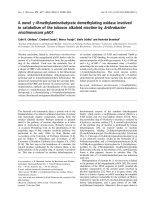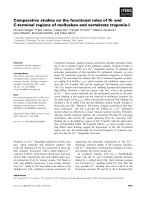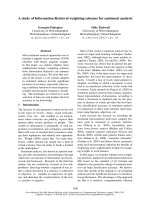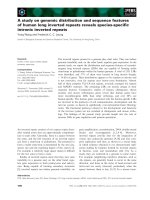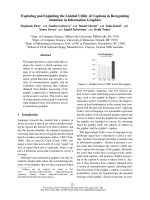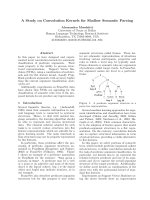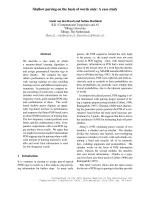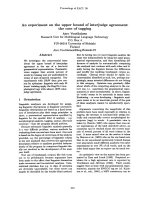Báo cáo khoa học: "A study on the immunocytochemical localization of neurofascin in rat sciatic nerve" doc
Bạn đang xem bản rút gọn của tài liệu. Xem và tải ngay bản đầy đủ của tài liệu tại đây (200.7 KB, 5 trang )
-2851$/# 2)
9HWHULQDU\#
6FLHQFH
J. Vet. Sci. (2000),1(2), 67–71
A study on the immunocytochemical localization of neurofascin in rat
sciatic nerve
Byung-joon Chang, Ik-hyun Cho and Peter J. Brophy
1
Department of Anatomy and Histology, College of Veterinary Medicine, Konkuk University, Seoul 143-701, Korea
1
Department of Preclinical Veterinary Sciences, University of Edinburgh, Edinburgh EH9 1QH, UK
We examined the localization of neurofascin (NF) in the
sciatic nerve of rat. In the myelinated fibers, neurofascin
localizes strongly in the nodal axolemma except the small
central cleft and also expresses in the paranodes, and
weakly in the Schmidt-Lanterman incisures. In the
paranodes, NF localizes around the axolemma and it
expresses in the apposing membrane of paranodal loops.
Axoplasm, compact myelin and cytoplasm of Schwann
cell do not express NF at all. In the Schmidt-Lanterman
incisures, NF is expressed weakly along the Schwann cell
membrane. We propose that neurofascin may be a
plasmalemmal integral protein of Schwann cell in the
paranode and plays some important roles for the
maintenance of axo-glial junctions at the paranode. It
may also have some roles for maintaining the structure of
Schmidt-Lanterman incisure and have some relations
with proteins localizing in the node.
Key words:
neurofascin, axo-glial junction, Schmidt-Lanter-
man incisure, immunocytochemistry
Introduction
Neurofascin is an axon-associated member of the L1
subgroup of the immunoglobulin superfamily that is implicated
in the processes during the development of the nervous
system such as cell adhesion, cell migration, neurite out-
growth, and fasciculation [3, 10, 11, 14, 20]. Neurofascin
is concentrated in developing fiber tracts at early stages of
development [15, 17]. At later stages of development,
neurofascin is more widely expressed in the nervous
system [13]. Neurofascin is characterized by extracellular
domains comprised of 6 immunoglobulin domains and 4
fibronectin type III domains and cytoplasmic domains
containing an ankyrin-binding site localized to a highly
conserved stretch of amino acids. The intracellular segment
of neurofascin as well as those of other members of the L1
subgroup interact with the cytoskeletal component ankyrin
[4,6,7].
To elucidate the exact localization of neurofascin in the
peripheral nerves is important to clarify the function of this
molecule. In this report we have examined the
ultrastructural localization of neurofascin in rat sciatic
nerve, and we got some important findings of NF
localization in the node, paranode, and Schmidt-
Lanterman incisure. From our investigations we suppose
there are some related functions with its specific
localization in the peripheral nerves.
Materials and Methods
Animals
Twenty Sprague-Dawley rats (Daehan Lab. Animal Res.
Center, Korea), 5 to 8 weeks old and weighing 150-
200 gm, were provided with basal diet and tap water ad
libitum during the experiment.
Immunofluorescence
Animals were anesthetised by inhalation of ether and
perfused with 4% paraformaldehyde. Sciatic nerves were
exposed in the upper thigh level and excised nerves were
fixed with the same fixative for 2 hours at room
temperature (RT). Nerves for longitudinal and cross
sections were washed 3
15 min with PBS and treated
with 5%, 10%, and 25% sucrose and embedded with OCT
compound (Sakura Fine Tech., Japan). Ten
µ
m sections
were collected on TESPA (3-aminopropyltriethoxy-silane;
Sigma-Aldrich, Korea) coated slides and allowed to dry
for 2 hours at RT. Nerves for teased fiber were washed 4
15 min with PBS. Teased fibers were prepared by
separating each sciatic nerve fiber with acupuncture
needles. Teasing procedure was performed after soaking in
the solution of 0.1% Triton X
−
100 for 3 hours after
removing epineurium.
*Corresponding author
Phone: 82-2-450-3711; Fax: 82-2-3437-3661
E-mail:
68 Byung-joon Chang et al.
Nerves were washed with PBS and blocked for 1 hour with
10% goat serum in 0.2% gelatin, 0.3% Triton X-100 in
PBS (buffer A). Nerves were incubated overnight with 1 :
4000 goat anti-rabbit neurofascin (from Dr. Brophy, Univ.
of Edinburgh) diluted in 4% goat serum, buffer A and
washed 3
20 min with buffer A. Nerves were incubated
in 1 : 200 goat anti-rabbit FITC (Vector, U.S.A) diluted in
buffer A for 3 hours at RT and washed 4
5 min with PBS.
After draining off most of PBS and coverslipped with
Vectashield.
Immunoelectron microscopy
Animals were anesthetised by inhalation of ether and
perfused with a mixture of 4% paraformaldehyde and
0.2% glutaraldehyde. Each side of sciatic nerve was cut
and fixed for 3 hours with the same fixatives. Fixed tissues
were washed 3 times with 0.1 M phosphate buffer and
dehydrated for 2 min with 30%, 50%, 70%, 90%, and
100% ethanol respectively. After infiltrating with a
mixture of LR gold and ethanol, tissues were embedded
with LR gold at
−
25
o
C under ultraviolet lamp. Thin
sections were cut with ultramicrotome and collected on
Formvar coated nickel grid and dried. Sections were
blocked with PBS-Milk-Tween (0.1M PBS, 0.2% milk,
0.1% Tween 20) for 30 min and incubated with 1 : 200
goat anti-rabbit neurofascin for 12 hours at 4
o
C. After
washing with PBS-BSA-Tween (0.1M PBS, 0.2% BSA,
0.1% Tween 20), sections were incubated with 1 : 50 15
nm gold particles conjugated with goat anti-rabbit IgG
(British Biocell International, U.K.) for 2 hours at RT.
Sections were washed with PB-Tween (0.1 M phosphate
buffer, 0.1% Tween 20), and then fixed with 2.5%
glutaraldehyde for 15 min, and stained with uranyl acetate-
lead citrate and observed with JEOL 1200 EXII TEM
under 60 Kv.
Results
Immunofluescence
Strong expression of neurofascin was detected throughout
the nerve fibers intermittently in both longitudinal sections
and teased fibers of sciatic nerve (Fig 1A & 1B). This
strong expression of NF was defined around the axonal
circumference and their staining areas look like slender
rectangular appearance with a small central cleft. With
electron microscopical immunocytochemistry, the rectangular
area was identified to be the node and paranode. Although
nodes are stained strongly with NF, there is a small
unstained central cleft in the node. Paranodes are stained
strongly as well, but the strength of immunoreaction
toward the internode was getting weaker. In addition to the
strong immunoreactive regions of nodes and paranodes,
very many weak expression sites of NF were also detected
in the longitudinal sections and teased fibers. These
narrow regions of NF expression were scattered
throughout the internode and these structures were turned
out to be the Schmidt-Lanterman incisures. In the cross
sections, NF immunoreaction was clearly expressed
around the axonal circumference and no immunoreaction
were detected in axoplasm and compact myelin layers (Fig
1C).
Fig 1.
Immunofluorescence of NF in 8 weeks old rat sciatic
nerve. (A) Longitudinal sectioned. NF is expressed in the nodes
and paranodes (arrow heads) strongly and Schmidt-Lanterman
incisures (arrows) weakly. (B) Teased fibers. A node of Ranvier
and 2 Schmidt-Lanterman incisures are shown. The node and
paranode (arrow head) express NF strongly except the small
central cleft. Schmidt-Lanterman incisures (arrows) also express
NF. (C) Cross sectioned. NF is expressed around the axonal
circumference (arrow heads) strongly. Bar = 10
µ
m
A study on the immunocytochemical localization of neurofascin in rat sciatic nerve 69
Immunoelectron microscopy
With electron microscopy, we identified NF immunoreactive
gold particles were expressed in the nodal axolemma
except a small central cleft of nodes (Fig 2A). NF
immunoreactive gold particles were also detected in the
membranes of paranodal loops as well. Besides the nodes
and paranodes, NF immunoreactive gold particles were
seen in the Schmidt-Lanterman incisures weakly (Fig 2B).
There was no immunoreactive gold particles found in
axoplasm, compact myelin, and internodal axolemma.
Discussion
Cell adhesion molecules (CAMs) play an important role in
both the initiation and signaling of axon-glial contact.
Among them, neurofascin is a chick neurite-associated
surface glycoprotein implicated in axon extension [15] and
this molecule is a powerful candidate for recognizing the
axons that they ensheath during the development. In the
CNS, neurofascin is strongly but transiently up-regulated
in oligodendrocytes at the onset of myelinogenesis. After
the initial surge of neurofascin expression in oligoden-
drocytes, there is a shift to a predominantly neuronal
localization that persists into adulthood [1].
Neurofascin in adult rat brain includes polypeptides of
186 kD and 155 kD and a minor form of 140 kD confined
to the cerebellum. Antibody that recognized 186, 155, and
140 kD neurofascin cross-react strongly with the node of
Ranvier. Immunoblots of sciatic nerve revealed the 155 kD
polypeptide as the major form of neurofascin, and thus a
candidate for the isoform of neurofascin at the node of
Ranvier [6].
In this report we describe the localization of neurofascin
which recognizing 155 kD and 186 kD polypeptides in the
sciatic nerve of rat. Davis et al. [5] reported the 186 kD
neurofascin is the major form in adult brain and is present
at specialized membrane domains including nodes of
Ranvier and axonal initial segments, and an alternative
form of 155 kD neurofascin localizes in paranodal region.
In this study we identified the NF localizes strongly in the
nodes and paranodal loops and it is in consistent with the
result of Davis et al. [5]. We have also identified the NF
was expressed in the nodal axolemma except the small
central cleft. This data is not completely in agreement with
Fig 2.
Post-embedding immunoelectron microscopy of NF expression in 8 weeks old rat sciatic nerve. (A) Node (N) and paranode (Pn).
NF immunoreactive gold particles are localized in the nodal axolemma (arrows) except the small central cleft (asterisks). NF expression
was revealed in the paranodal loops (PL; large arrow heads). (B) Internode. NF immunoreactive gold particles were localized only in the
Schmidt-Lanterman incisure (SL; small arrow heads). There is no NF expression at the axolemma of internode (broken arrows). My;
myelin sheath. Ax; axon. Bar = 500 nm
70 Byung-joon Chang et al.
the result of Davis et al. [5]. They investigated the NF
localization with immunofluorescence. In this report we
also identified the small non-immunoreactive areas of NF
in the central zone of the nodes. These two findings seem
to be not very different in immunofluorescence, but the
existence of NF at the large area of nodal axolemma in this
study was obviously elucidated with post-embedding
immunoelectron microscopy. From the findings of this
study we suggest NF in the nodal axolemma may have
some relations with other molecules localizing in the node,
like ankyrin and voltage-dependent sodium channels.
NF immunoreaction in this study was strong in the
paranodes and many immunoreactive gold particles localizes
in the Schwann cell membrane of paranodal loops. This
finding is in agreement with the study of Tait et al. [19] and
it suggests NF may be a component of Schwann cell
membrane protein and it is likely to interact with some
axonal membrane proteins in the paranode.
We have firstly identified the NF was expressed in the
Schmidt-Lanterman incisures, which are spirals of cytoplasm
inserted between lamellae of the myelin sheath connecting
the inner and outer layers of Schwann cell or oligo-
dendroglial cytoplasm. Numerous investigations of normal
and pathological peripheral nerve have focused on the
Schmidt-Lanterman incisures [2, 8, 12, 16, 18], yet their
precise role has not been determined. Ghabriel and Allt [8]
suggested the possible roles of Schmidt-Lanterman incisure
are metabolic maintenance of the myelin sheath, transport
of metabolites through the sheath to the axon, a
mechanism providing for longitudinal growth of myelin
segments, and contribution to peristaltic movement of
axoplasm. According to the suggestion of the metabolic
functions of Schmidt-Lanterman incisure, NF may have
some roles to maintain the myelin structures. We suggest
the localization of NF in the Schmidt-Lanterman incisures
may be important to stabilize the apposed Schwann cell
membranes at the incisures and paranodes. And it may also
be interesting to reveal the presence of incisures during the
earliest stages of myelination and the initial expression of
neurofascin in the incisure.
The cytoplasmic domains of neurofascin contain highly
conserved region that associates with the membrane-
skeletal protein ankyrin [4, 6, 7, 9]. In this study, we report
the existence of neurofascin in the node, and then it may
explain neurofascin has some relation with some other
molecules including ankyrin, spectrin, voltage-dependent
sodium channels, which are mainly localized in the node.
We examined there is no evidence of NF staining in the
axoplasm, compact myelin, and Schwann cell cytoplasm,
so it is obvious that neurofascin is not a constituent of
myelin and has not any important roles in the axoplasm
and cytoplasm of Schwann cell.
From these investigations of NF localization in rat
sciatic nerve, we propose that neurofascin may be a
plasmalemmal integral protein of Schwann cell in the
paranode and plays some important roles for the
maintenance of axo-glial junctions at the paranode. It may
also have some roles for maintaining the structure of
Schmidt-Lanterman incisure and have some relations with
proteins localizing in the node. Further study about the
initial expression of neurofascin in peripheral nerves will
be necessary to identify further the roles of this molecule
in peripheral nerves.
Acknowledgement
The authors wish to express gratitude to Mr. Byung-hwa
Chang for the technical support of immunoelectron
microscopy.
References
1.
Collinson J. M., Marshall D., Gillespie C. S., and Brophy P.
J.
Transient expression of neurofascin by oligodendrocytes
at the onset of myelinogenesis: Implications for mechanisms
of axon-glial interaction. Glia, 1998,
23
, 11-23
2.
Cooper N. A. and Kidman A. D.
Quantitation of the
Schmidt-Lanterman incisures in juvenile, adult, remyelinated
and regenerated fibers of the chicken sciatic nerve. Acta
Neuropathol Berl, 1984,
64
, 251-258
3.
Cunningham B. A.
Cell adhesion molecules as
morphoregulators. Curr Opin Cell Biol, 1995,
7
, 628-633
4.
Davis J. Q., and Bennett V.
Ankyrin-binding activity
shared by the neurofascin/L1/NrCAM family of nervous
system cell adhesion molecules. J Biol Chem, 1994,
269
,
27163-27166
5.
Davis J. Q., Lambert S., and Bennett V.
Molecular
composition of the node of Ranvier: identification of
ankyrin-binding cell adhesion molecules neurofascin
(mucin+/third FNIIIdomain-) and NrCAM at nodal axon
segments. J Cell Biol, 1996,
135
, 1355-1367
6.
Davis J. Q., McLaughlin T., and Bennett V.
Ankyrin-
binding proteins related to nervous system cell adhesion
molecules: candidates to provide transmembrane and
intracellular connections in adult brain. J Cell Biol, 1993,
121
, 121-133
7.
Dubreuil R. R., MacVicar G., Dissanayake S., Liu C.,
Homer D., and Hortsch M.
Neuroglian-mediated cell
adhesion induces assembly of the membrane skeleton at cell
contact sites. J Cell Biol, 1996,
133
, 647-655
8. Gabriel M. N. and Allt G. Incisures of Schmidt-Lanterman.
Prog Neubiol, 1981,
17
, 25-58
9.
Garver T., Ren Q., Tuvia S., and Bennett V.
Tyrosine
phosphorylation at a site highly conserved in the L1 family
of cell adhesion molecules abolishes ankyrin binding and
increases lateral mobility of neurofascin. J Cell Biol, 1997,
137
, 703-714
10.
Grumet M., Mauro V., Burgoon M. P., Edelman G. M.,
and Cunningham B. A.
Structure of a new nervous system
glycoprotein, Nr-CAM, and its relationship to subgroups of
A study on the immunocytochemical localization of neurofascin in rat sciatic nerve 71
neural cell adhesion molecules. J Cell Biol, 1991,
113
, 1399-
1412
11.
Hortsch M.
The L1 family of neuronal cell adhesion
molecules: Old proteins performing new tricks. Neuron
1995,
17
, 587-593
12.
Krinke G., Grieve A. P., and Schnider K.
The role of
Schmidt-Lanterman incisures in Wallerian degeneration.
Acta Neurophathol Berl, 1986,
69
, 168-170
13.
Moscoso L. M. and Sanes J. R.
Expression of 4
immunoglobulin superfamily adhesion molecules (L1, Nr-
CAM/Bravo, neurofascin/ABGP, and N-CAM) in the
developing mouse spinal cord. J Comp Neurol, 1995,
352
,
321-334
14.
Rathjen F. G. and Schachner M.
Immunocytochemical
and biolochemical characterization of a new neuronal cell-
surface component(L1-antigen) which is involved in cell-
adhesion. EMBO, J 1984,
3
, 1-10
15.
Rathjen F. G., Wolff J. M., Chang S., Bonhoeffer F., and
Raper J. A.
Neurofascin: A novel chick cell-surface
glycoprotein involved in neurite-neurite interactions. Cell
1987,
51
, 841-849
16.
Reynolds R. J. and Heath J. W.
Patterns of morphological
variation within myelin internodes of normal peripheral
nerve: quantitative analysis by confocal microscopy. J Anat,
1995,
187
, 369-378
17.
Shiga T. and Oppenheim R. W.
Immunolocalization
studies of putative guidance molecules used by axons and
growth cones of intersegmental interneurons in the chick
embryo spinal cord. J Comp Neurol, 1991,
310
, 234-252
18.
Small J. R., Ghabriel M. N., and Allt G.
The development
of Schmidt-Lanterman incisures: an electron microscope
study. J Anat, 1987,
150
, 277-286
19.
Tait S., Gunn-More F., Collinson J. M., Huang J.,
Lubetzki C., Pedraza L., Sherman D. L., Colman D. R.,
and Brophy P. J.
An oligodendrocyte cell adhesion
molecule at the site of assembly of the paranodal axo-glial
junction. J Cell Biol, 2000,
150
(3), 657-666
20.
Volkmer H., Hassel B., Wolff J. M., Frank R., and
Rathjen F. G.
Structure of the axonal surface recognition
molecule neurofascin and its relationship to a neural
subgroup of the immunoglobulin superfamily. J Cell Biol,
1992,
118
, 149-161
